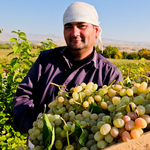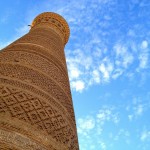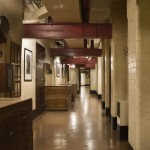Andy Mossack reports back from discovering Uzbekistan with small group escorted tour operator Jules Verne on a thoroughly enjoyable Silk Road adventure.
A glorious balmy evening, and I was enjoying some light-hearted haggling with Samira and Zarina in their clothes shop in Bukhara’s old town.
We were talking literally thousands of sum, Uzbekistan’s inflation inflicted currency, which replaced the rouble in 1994. Samira had already reduced her price by 50,000 sum (around £3), but I was having none of it, standing my ground for another 20,000 (around £1.20), after all, I was buying two garments. Fair’s fair.
In the end we settled on 600,000 (£36) for a silk trouser suit and silk/cotton dress for Mrs M, “handmade by my aunt” Samira told me. And, it must be said, the workmanship and material quality were excellent. This is the Silk Road after all, there is a Ministry of Silk in Tashkent and from the number of silk farms we passed enroute to Bukhara, silk quality is a given.

Uzbekistan’s rise in popularity as a serious tourist destination, is entirely justified in my opinion. Not only does it have an extraordinary ancient history boasting a hat trick of UNESCO World Heritage cities – Khiva, Bukhara and Samarkand – but its streets are spotless, its people warm and welcoming, and its cuisine is delicious and colourful. Plus, as I’ve already pointed out, it is insanely good value for money.
Sophie Ibbotson’s beautifully rendered Insider Guide to Uzbekistan featured on TripReporter, describes the Islamic architectural wonders of this fabulous country, so instead I’m going to introduce the people you might meet, along with some other places you really shouldn’t miss beyond the stunning architecture.
Tashkent
Uzbekistan’s capital, once the fourth largest city in the old Soviet Union, might not have the marquee status of Khiva, Bukhara or Samarkand, but like a shy wallflower at the school disco, once you give it a little attention it might just surprise you. it’s often bypassed on tour itineraries, but I think it is well worth two or three days to wander around.
Tashkent is a bustling city of contradictions. The religious old city dating back to the 16th century, the new city (post-earthquake) with its trendy restaurants, museums and malls (the brand-new City Mall opened this year) and the numerous Soviet-era buildings, a constant reminder of its communist past. It also has an obsession with Ferris wheels as does the rest of the country. Tashkent has seven of them!


It’s a surprisingly green city with plenty of parks and open spaces, the largest of which is the 18-hectare City Park with its impressive musical fountain show every evening and weekends. You’ll find walnut, poplar and mulberry trees in plentiful supply, while Myna birds will always be constantly around for company.
The streets are spotless, courtesy of the State controlled cleaners. Every piece of plastic is picked up and recycled. They say the open spaces are thanks in no small part to the 8.3 magnitude earthquake in 1966, and the impressive Monument of Courage was built right at the epicentre. A cracked plinth signifies the destruction, while a metallic relief tapestry behind describes Tashkent’s rebuild from the ashes.


Tashkent Metro: The oldest underground in central Asia, is a cheap, fast and reliable way to get around the city, yet many of the stations are themed works of art too. Kosmonavtlar’s stunning space theme is dedicated to famous Russian cosmonauts like Yuri Gagarin, the first man, and Valentina Tereshkov, the first woman in space. Or how about the sweeping marble columns and chandeliers of Mustaqilliq Maidoni (Independent Square). Why not buy one token for 1,400 sum (£0.8p) and you can visit all 29 stations!
The Chorsu Bazaar is Tashkent’s most famous market that’s been here since the 12th century, although there are many more dotted about the city. Here, the sounds, colours and smells offer an authentic glimpse of Uzbek life. Mounds of exotic spices, fresh fruits, sweets, meats and fish abound.
But my personal favourite was the bakery. Huge wheels of crusty bubbled non (breads) emerging on a long spade from an ancient furnace and laid lovingly on an adjacent trestle. The intoxicating smell of freshly baked bread seducing even the coldest of hearts. This was love at first taste. The baker gave me a knowing glance and smiled. He knew I would be smitten.


Khiva
Once I strolled through the Ota Darvoza, the main gate of Khiva’s mudbrick-walled old city known locally as Ichan Qala, the significance of this place hit home. A Kyzyl Kum desert citadel with 2,500 years of blood-soaked history from Genghis Khan and Amir Temur to a 17th century slave supermarket lasting over 200 years.
Nevertheless, this brutal history defines Khiva’s importance on the Silk Road. A fortified desert oasis some 620 miles from Tashkent, where wandering merchants could ply their trade and rest their weary camel trains at a nearby caravanserai.
The well-trodden paving stones of the narrow streets still teem with artisan merchants selling everything from real Astrakhan fur hats and silks to woodcarving, carpet weaving and ceramics. Take Matia for example, a lovely gentleman I later discovered was a legendary puppet master. I found him by chance outside his tiny shop laying out ceramic plates, one of which I happened to be looking for.

Beckoning me inside, I was surrounded by handmade puppets and instantly a little suspicious. He told me “It takes me a week to make each one of these” and promptly put on a glove puppet and gave me an impromptu show. Turned out he was a master puppeteer and represented Uzbekistan in an international competition in London a few years ago. My suspicions were unfounded, and he was delighted to sell me his handmade ceramic plate for the princely sum of £6 (100,000 sum). Matia, what a guy.


I found old Khiva an assault on the senses. But in a good way. A compact city easily walkable, packed with over sixty cultural gems. The sights, colours, sounds and smells of ancient Asia. Its rampart walls proudly guarding a UNESCO World Heritage masterpiece. Come the balmy evening, once the hot sun was gone, I climbed the ramparts and took in another view, one of Ichan Qala under the stars, transformed by twinkling lights. Spiritual and unmissable.
Bukhara
Desert Drive: It’s a good six-hour drive across the sand and rock Kyzyl Kum Desert from Khiva to Bukhara, a journey not without one or two interesting distractions which you would miss if you took the train. The bridge across the Oxus River for a start. Known as the ‘mother of rivers’ a just moniker perhaps as the Oxus flows through four countries and provides Uzbekistan with a natural border with Afghanistan before flowing into the famed Aral Sea.
Just a narrow single lane bridge offers the only desert crossing which must also be shared with a train line. It is a bizarre situation to have a mini traffic jam in the middle of a desert. Then there’s the Sunnat Aka restaurant; a veritable oasis in the middle of nowhere and the perfect lunch pit stop on a long drive. A banquet of barbecued kebabs and rice, hot bread, and even (gasp) a coffee machine!

Old Town: Bukhara’s significance to the Silk Road is evident in the sheer scale of the old city and the grandeur of its numerous mosques and madrassahs, marking its position as a major centre of religious and intellectual studies for over a thousand years. That said, probably the grandest structure apart from the lofty Kalyan minaret has to be the immense 5th century Ark Fortress and Palace, Bukhara’s oldest structure. Take a tour around it and hear gruesome stories of its various brutal Governors during its heyday when over 800 people lived in there.
Evening is when the old town really comes alive and local families are out, particularly around the Mulberry treelined Lyab-i-Hauz plaza (translated as around the pool), a terrific spot for people watching. There’s plenty of cafes and restaurants surrounding the pool and fountain complex. Look for the statue of a chap riding a donkey in front of the large madrassah at the east end.


He is Nasruddin Hodja a legendary 13th century Silk Road character who became a notorious storyteller. He and his donkey have become folklore throughout Asia, and many people rub the donkey for luck! I grew quite fond of old Nas and saw him pop up in many pieces of art in the galleries around the old town.
Lose yourself in the bazaars and wander into the numerous caravanserai courtyards where you’ll often find exceptional master craftsmen at work.
Minature Art: Just outside the city is the home, school and studio of Davron Toshev, a quite remarkable master miniaturist. His live-in school teaches students the art of miniature painting, a form of artistry that is fast becoming recognised by major auction houses as a potentially collectable market.
His sprawling estate is practically self-sufficient, growing fruit and vegetables, and even making his own paper using age old techniques. They even breed giant rabbits and use their hair for paint brushes. Showing me around his studio and gallery, it was clear this form of fine art takes endless hours of painstaking labour. “Each piece has to tell a story, that’s why the detail is important” he told me as we were watching a student paint using a magnifying lens. Remarkable.


Not far from Toshev’s home studio, another unusual destination awaited – the Summer Palace of Alim Khan, the last Emir of Bukhara. Originally built in 1918 for the visit of the doomed Tzar Nicholas II and his family. They never made the trip because of the Russian revolution. It’s unusual because the architectural style is European Russian a result of the Emir’s own trip to St. Petersburg.
It’s set in beautifully serene grounds with roaming peacocks meandering around while the interior houses the Museum of Decorative and Applied Arts. It’s also worth taking a look at the Emir’s harem building by the pool. On a hot summer’s day, it’s a lovely spot to relax under a shady tree and watch the wildlife.
Samarkand
Sitting at the crossroads of trade routes and cultures, Uzbekistan’s third UNESCO city and, perhaps the headline act on any tour, has been a strategic prize for invaders and warlords going back to Alexander the Great. No wonder Timur, the last of the great nomadic conquerors and idolised in Uzbekistan, made this his base city. It’s also his last resting place, and his mausoleum at Gur-e-Amir is well worth a visit. (If you think it strikes a familiar pose to the Taj Mahal, it’s because Timur’s Indian descendants built it!)


It’s also one of the oldest inhabited cities in Asia perhaps the reason it’s such a cosmopolitan magnet, attracting communities not just from former Soviet states, but Iran, Korea and Germany. For centuries there was even a large population of Bukharian Jews before most of them emigrated in the 1970s.
I’d just arrived after a four-hour drive from Bukhara sitting with Marat my excellent Jules Verne tour guide having lunch in a roof top restaurant. We were gazing out at the azure domes around Samarkand when Marat said, “they use cobalt in those domes to unite the earth with the sky”. Sitting up there, I felt another spiritual moment coming on.
Ancient Observatory: The three colossal madrassahs of Registan Square might be the centre of Samarkand’s tourist universe, but I visited another universe entirely: the quite magnificent Ulugh Beg Observatory. This 14th century observatory was built around 1420 by astronomer and mathematician Ulugh Beg, the grandson of Timur no less and was famous across Asia. It was destroyed in 1449 and lay undiscovered until 1908. This ingenious invention used a giant mechanical sextant to map out the known universe and to see the marble sliding mechanism today is something remarkable.

There’s also an excellent museum on the site with information on how those ancient astronomers managed to work out the universe and the tools they used.
Invite to a Family Dinner: One aspect of this Jules Verne tour that took me completely by surprise was to enjoy a dinner with a local Samarkand family. Daughter Dinora spoke excellent English and we arrived in time for her mother to show us how she made her plov, Uzbekistan’s beloved national dish.
Every family has their own recipe for this rice, meat and vegetable staple handed down through the generations, but in each recipe, the order the ingredients are cooked is always the same. This feast, out in the family courtyard, was fit for an Emir . And we were even treated to a traditional dance by Dinora’s two lovely girls. What a privilege.


Uzbekistan is light years away from a drop and flop holiday, but if you enjoy adventure and history and the embrace of warm hospitable people it can’t be beaten. You’ll get great value too, just ask Samira at her dress shop opposite the oriental tea house in Bukhara.
All images (C) Andy Mossack except feature image of Bukhara and Carpet Weaver (C) iStock.com/Mlenny, and Kukeldash-Madrasa Tashkent (C) iStock.com/Leonid-Andronov.
Tell me more about discovering Uzbekistan with Jules Verne
Andy’s feature is based on Jules Verne’s Golden Road to Samarkand Tour an 11 night Uzbekistan adventure. 11 nights from £2,595
With 45 years’ experience, Jules Verne visits iconic landmarks and lesser-known sites, with expert tour guides who share their local knowledge and show you hidden gems. Every Jules Verne traveller is guaranteed a unique, quality experience within a small group of around fifteen like-minded companions.






